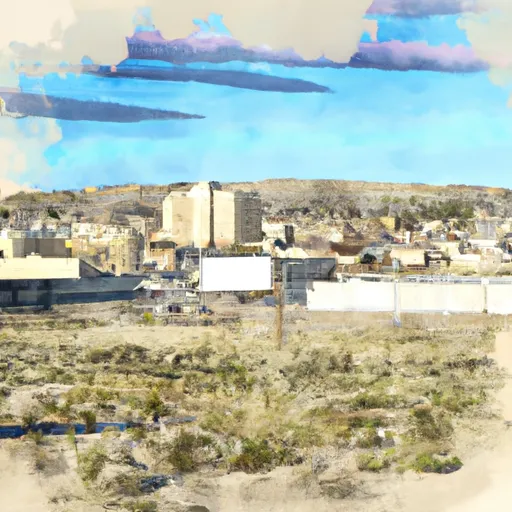-
 Snoflo Premium
Snoflo Premium
Get unlimited access to all our content
With no Ad interruptions! - Start Your Free Trial Login with existing account
Rawlins
Eden Index
Climate
6.8
•
Recreation
1.8
•
Community
•
Safeguard
3.3/10

Rawlins, Wyoming is a charming city located in Carbon County, in the south-central part of the state. Known for its diverse climate, Rawlins experiences hot summers and cold winters due to its high elevation, sitting at 6,827 feet above sea level. Summers are typically mild, with temperatures averaging in the mid-80s Fahrenheit, while winters can be harsh with temperatures dropping below freezing.
Hydrologically, Rawlins is situated near the North Platte River, which provides a reliable water source to the city and supports various recreational activities. Additionally, the city is surrounded by rugged mountain ranges, including the Snowy Range and Sierra Madre Mountains, offering breathtaking landscapes and opportunities for outdoor enthusiasts.
In terms of recreation, Rawlins is a haven for outdoor activities such as hiking, mountain biking, fishing, and hunting. The nearby Medicine Bow National Forest provides ample opportunities for exploration and adventure with its numerous trails and camping sites. Additionally, the Seminoe State Park and Pathfinder Reservoir offer excellent fishing, boating, and camping experiences. With its diverse climate, hydrological features, and outdoor recreational opportunities, Rawlins, Wyoming is a paradise for nature lovers.
What is the Eden Index?
The Snoflo Eden Index serves as a comprehensive rating system for regions, evaluating their desirability through a holistic assessment of climate health, outdoor recreation opportunities, and natural disaster risk, acknowledging the profound impact of these factors on livability and well-being.
Climate Health Indicator (CHI): 6.8
Rawlins receives approximately
257mm of rain per year,
with humidity levels near 68%
and air temperatures averaging around
6°C.
Rawlins has a plant hardyness factor of
5, meaning
plants and agriculture in this region thrive during a short period during spring and early summer. Most
plants will die off during the colder winter months.
By considering the ideal temperature range, reliable water supplies, clean air, and stable seasonal rain or snowpacks, the Climate Health Indicator (CHI) underscores the significance of a healthy climate as the foundation for quality living.
A healthy climate is paramount for ensuring a high quality of life and livability in a region, fostering both physical well-being and environmental harmony. This can be characterized by ideal temperatures, reliable access to water supplies, clean air, and consistent seasonal rain or snowpacks.
Weather Forecast
Streamflow Conditions
Great Divide Closed Basin
Area Rivers
Great Divide Closed Basin
Snowpack Depths
Great Divide Closed Basin
Reservoir Storage Capacity
Great Divide Closed Basin
Groundwater Levels
Recreational Opportunity Index (ROI): 1.8
The Recreational Opportunity Index (ROI) recognizes the value of outdoor recreational options, such as parks, hiking trails, camping sites, and fishing spots, while acknowledging that climate plays a pivotal role in ensuring the comfort and consistency of these experiences.
Access to outdoor recreational opportunities, encompassing activities such as parks, hiking, camping, and fishing, is crucial for overall well-being, and the climate plays a pivotal role in enabling and enhancing these experiences, ensuring that individuals can engage in nature-based activities comfortably and consistently.
Camping Areas
| Campground | Campsites | Reservations | Toilets | Showers | Elevation |
|---|---|---|---|---|---|
| Teton Reservoir | 5 | 7,047 ft | |||
| Jack Creek | 16 | 8,381 ft |
Nearby Fishing
Nearby Ski Areas
Catastrophe Safeguard Index (CSI):
The Catastrophe Safeguard Index (CSI) recognizes that natural disaster risk, encompassing floods, fires, hurricanes, and tornadoes, can drastically affect safety and the overall appeal of an area.
The level of natural disaster risk in a region significantly affects safety and the overall livability, with climate change amplifying these risks by potentially increasing the frequency and intensity of events like floods, fires, hurricanes, and tornadoes, thereby posing substantial challenges to community resilience and well-being.
Community Resilience Indicator (CRI):
The Community Resilience Indicator (CRI) recognizes that education, healthcare, and socioeconomics are crucial to the well-being of a region. The CRI acknowledges the profound impact of these elements on residents' overall quality of life. By evaluating educational resources, healthcare accessibility, and economic inclusivity, the index captures the essential aspects that contribute to a thriving community, fostering resident satisfaction, equity, and social cohesion.

